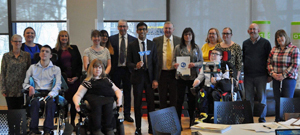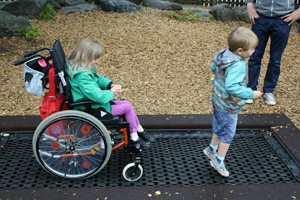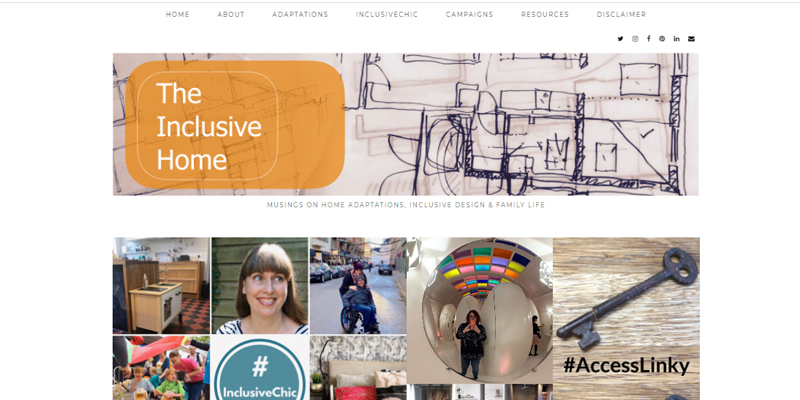Vaila Morrison is an architect with a passion for inclusive design and sustainability. She is also a mum and carer to a young daughter with significant disabilities (attributed to rare genetic condition KAT6A Syndrome), and a young son. Vaila is busy working on The Inclusive Home, a project which encourages architects and designers to produce places and spaces which will welcome people of all needs.

“It’s really not that easy to lead an inclusive life! There are so many barriers outside your control that mess up access and natural inclusion, and snooker your ability to try to enable inclusion. From the shortage of inclusive activities, to the challenge of accessing public transport, and the lack of the most basic facilities suitable for disabled people.”
A MASSIVE achievement for people power
Last time we spoke, I was very focussed on the Changing Places Toilet (CPT) campaign. Changing Places Toilets are a type of accessible toilet for people (like my daughter) who may need some help to use the loo and/or need access to a changing bench and hoist for transfers. They are a bit bigger than the average ‘disabled toilet’, to allow for assistants and larger wheelchairs and to accommodate the changing bench.
These toilets are unfortunately very few and far between. My home city of Cambridge has only one in the city centre (by that I mean no toilet in any cinema, theatre, museum, bar, restaurant, train station…). Imagine visiting a city with only one toilet you can use!?
The CPT campaign is about raising awareness of the need for these loos, but also about lobbying for changes to legislation, to ensure that a more equitable range of toilet facilities are installed in large new buildings.
The campaign had been gathering momentum when we last spoke. From conversations I’d had with access professionals, and those involved in helping to shape building standards and regulations, CPTs were one of the topics they received most questions from the public about!

In February 2018, fabulous campaigner Lorna Fillingham along with Paralympian Anne Wafula Strike delivered a petition with the request to change the building regulations, to Downing Street.
Following that, a number of workshops were held with various campaigners. One I attended was with, now chancellor, Rishi Sunak no less, who has been a great champion of the CPT campaign! A public consultation was then launched over the summer of 2019.
The accumulation of all this resulted in an amazing announcement on Changing Places Awareness Day this year (19th July 2020), that the Government have committed to amending the Building Regulations in England to include Changing Places Toilets in large public buildings and venues!
It’s a MASSIVE achievement for people power, and will make the world of difference to the 250,000 people and their families like ours who need these loos to access the world out there! In Scotland (ahead of the game!) there was also a change to building standards and a planning circular to put CPTs into new buildings!
In parallel to all this toilet activity, I’ve been getting back to my roots and focussing more on home design again!
The Inclusive Home
I launched my website when my family began our disabled adaptations journey and I realised there was a lack of helpful guidance and style inspiration out there for anyone looking to create or adapt their own an accessible home.
I’m hoping that the name of my site conjures up the idea of a home that would be accessible to all ages and abilities, welcoming to all family members and friends, future proof for life ahead. I considered various different names to go by, but I kept coming back to The Inclusive Home. It occurs to me now – if not then (I may be post rationalising!) that my outlook is not just about our house, of bricks and mortar, but about home life, inclusive living, about family.
You might then wonder – wouldn’t having an inclusive home life go without saying? Well actually, no.
It’s really not that easy to lead an inclusive life! There are so many barriers outside your control that mess up access and natural inclusion and snooker your ability to try to enable inclusion. From the shortage of inclusive activities to the challenge of accessing public transport, and the lack of the most basic facilities suitable for disabled people (here we come back to toilets again!).

Therefore trying to influence design of our public environment that is inclusive for everyone, is as much relevant to inclusive home life as our own house is, and so the context widens for my endeavours to help raise awareness about inclusive design and try to encourage the mainstream media and organisations to put it to the top of the agenda!
#InclusiveChic
Inclusive Chic came about when I met like-minded interior stylist Vicki (of Wheel Chic Home), who has also been trying to break the perception that accessible homes need to be clinical. We had been chatting about how difficult it was to find great inspiring examples. We decided to try circulating a hashtag on Instagram to start with, to try to encourage people to share their own experiences, ideas and hacks. We were thrilled to find lots of people responding, so we set up a dedicated Instagram account to curate some of our favourite examples!
There is always going to be a bit of a specialist market in adaptations for specific needs, but we’d love the hashtag and account to help break down the perception that inclusive design is a niche concept, and it would be fabulous to infiltrate the mainstream design media!
For a little bit more about the hashtag you can view our little intro slideshow here.
Putting inclusive design front and centre
Although the Changing Places Toilet campaign has reached a massive milestone, there is still a long way to go in raising awareness about just how important these facilities are! The building regulations are a minimum standard, and are only a requirement for new buildings, so there’s still lots of work to be done in making sure designers understand the need, to encourage existing venues to install them and those who maybe don’t fit the criteria, but would absolutely benefit from having one!
Vicki and I are hoping that Inclusive Chic will continue to expand, and we’d love to have more interaction with the home design media (specialist and mainstream)!
I’d love to see design awards (not just homes but all buildings and spaces!) put inclusive design front and centre of their judging criteria; for design quality accreditations to place emphasis on inclusive design, to put pressure on developers to properly integrate it into their processes; and for inclusive terminology to become mainstream!
In TV shows and articles for example, why not mention how great the pram access is in the context of a newly pregnant young couple’s home renovation or point out the handy downstairs loo (with walk-in shower!) for when grandma comes to visit!?
Another movement that needs to embrace access, is the sustainable design lobby. The climate crisis and sustainable development is such a crucial topic at the moment, and it seems to me that it’s essential that accessibility is put right up on that agenda. Buildings are for people after all, so it really isn’t sustainable to be building those that are not fit for ALL people, and it is certainly wasteful to design something that isn’t adaptable.
In construction, there’s always such a large time lag between new ways of thinking and designing and actually seeing the finished product.
I believe things are improving, and the success of the collective/people power of the Changing Places Toilet campaign is a great example of how, when in the thick of campaigning, it may feel like you are walking through treacle, or preaching to the choir, but in actual fact, at some stage, something may click, cogs may be turning and things can change!
A rollercoaster eight months
We have not been touched directly by any heartache due to COVID-19, so I’m happy to say that for us there have been many positives as well as negatives.
My daughter was in the shielding category for the majority of the ‘lockdown’ period, so the restriction on life was tricky, to say the least, and it has made me appreciate all the more, the ‘respite’ that school brings, to give me a little break from caring responsibilities. However, as neither of my children was in critical education years (and no matter how frustrating small children can be at times!) it has also lovely to step away from the pressures of routine and spend more time in our family bubble!
From a work point of view, it has been very difficult to do much of anything, especially during the day, but with my partner being able to work from home, he has been on hand to help out with kids at lunchtime etc. and he’s actually here at dinner time, something unheard of when he was commuting! This has freed up some time for me to work at the end of the day.
The world moving online has been a liberation! I’ve never been able to attend so many Continuing Professional Development (CPD) sessions, networking events and conferences. Even my social life has improved! Childcare for my daughter is very tricky, so to be able to have a glass of wine and a catch up with friends when we are all sitting comfortably on our own sofas has been brilliant.
Easing back into architectural work
At the moment, I’m doing quite a bit as a trustee of local charity, Shelford Playscape, hoping to deliver an innovative and inclusive playground. Playgrounds are another area of our built environment which are lacking much thought about accessibility, for disabled children to play together with siblings and friends, or for parents/grandparents to access. We’ve found in most playgrounds, even lovely new ones, on average just one piece of equipment that can be accessed in a wheelchair.

In terms of the future for The Inclusive Home, everything is a bit up in the air at the moment (as it is for everyone of course!), but my longer-term plan is to ease back into ‘doing’ architecture again.
With my hectic home life, I can’t see myself fitting into regular practice, but I feel there is a gap in the domestic architecture sector for guiding people through the home adaptations process in a design lead way.
The current focus for people accessing the government grant for home adaptations (Disabled Facility Grants) is very much lead by clinical need and those who cannot access the grant often feel very lost. There are very few access consultants who work in on the scale of individual home projects, and architects are generally having to try and join the dots with what statutory guidance is out there.
What I’d love to be able to do is help people with a specialist brief writing service that will help them to set down the parameters for their project that they can take to their chosen designer and be confident that their core access needs are clearly set out and integrated from the start. I’m hoping that will be helpful (and not a hindrance!) to fellow architects … but that remains to be seen!
https://www.linkedin.com/in/vailamorrison/
https://twitter.com/inclusivehome


